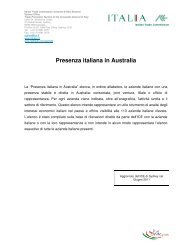Price Determination in the Australian Food Industry A Report
Price Determination in the Australian Food Industry A Report
Price Determination in the Australian Food Industry A Report
Create successful ePaper yourself
Turn your PDF publications into a flip-book with our unique Google optimized e-Paper software.
• assertions as to market power <strong>in</strong> <strong>the</strong> food sector;<br />
• <strong>the</strong> nature and scope of value-add<strong>in</strong>g <strong>in</strong> <strong>the</strong> food sector and <strong>the</strong> impact that such activities are<br />
hav<strong>in</strong>g on food pric<strong>in</strong>g and returns to each part of <strong>the</strong> <strong>in</strong>dustry; and<br />
• adjustment by parts of specific <strong>in</strong>dustries to ongo<strong>in</strong>g changes <strong>in</strong> market conditions.<br />
Information and knowledge<br />
It is not possible to make valid assertions about <strong>the</strong> nature, cause and real size of <strong>the</strong> marg<strong>in</strong><br />
between retail and farmgate prices without reliable <strong>in</strong>formation and relevant analysis.<br />
In general, whilst <strong>the</strong> quality of <strong>in</strong>formation useful for a study such as this varies across sectors of<br />
<strong>the</strong> food <strong>in</strong>dustry, <strong>the</strong> study has found a poor state of <strong>in</strong>formation relevant to a study of prices<br />
through value cha<strong>in</strong>s. While food and primary agricultural sectors have <strong>in</strong>creased <strong>the</strong><br />
specialisation and sophistication of <strong>the</strong>ir <strong>in</strong>vestments <strong>in</strong> product and market R&D <strong>in</strong> recent years,<br />
<strong>the</strong>re has been limited <strong>in</strong>vestment by most <strong>in</strong>dustries <strong>in</strong> knowledge management and <strong>in</strong>telligence.<br />
The <strong>in</strong>tensity of domestic competition and <strong>the</strong> consolidation of food supply contribute to this.<br />
The highly contested nature of <strong>the</strong> food sector, which manifests itself <strong>in</strong> aggressive buy<strong>in</strong>g<br />
practices at wholesale level, has created an atmosphere where suppliers are fearful of giv<strong>in</strong>g<br />
<strong>in</strong>formation away that exposes <strong>the</strong>ir underly<strong>in</strong>g costs and marg<strong>in</strong>s, or gives a competitor an<br />
advantage. The push by retail buyers to identify and share <strong>in</strong> product cost sav<strong>in</strong>gs creates an<br />
equally strong reluctance by food companies to participate <strong>in</strong> studies such as this or to ensure<br />
greater transparency for <strong>the</strong> sake of enhanc<strong>in</strong>g supplier knowledge.<br />
In general terms <strong>the</strong> state of <strong>in</strong>dustry <strong>in</strong>formation that is available <strong>in</strong> <strong>the</strong> primary food <strong>in</strong>dustries<br />
relevant to <strong>the</strong> l<strong>in</strong>es chosen for analysis <strong>in</strong> this study is of limited decision-mak<strong>in</strong>g value. It is<br />
<strong>in</strong>variably <strong>the</strong> case however that those suppliers who make <strong>the</strong> <strong>in</strong>vestment <strong>in</strong> knowledge and<br />
relationships are well aware of market realities – creat<strong>in</strong>g premiums over <strong>the</strong> average.<br />
Visibility<br />
<strong>Price</strong> <strong>Determ<strong>in</strong>ation</strong> <strong>in</strong> <strong>the</strong> <strong>Australian</strong> <strong>Food</strong> <strong>Industry</strong> A <strong>Report</strong><br />
4<br />
The lack of visibility of market conditions is a key <strong>in</strong>hibitor <strong>in</strong> fur<strong>the</strong>r development of fresh food<br />
supply cha<strong>in</strong>s where central markets play a key role. Despite <strong>the</strong> <strong>in</strong>creas<strong>in</strong>g role that direct supply<br />
has for major retailers, fresh wholesale markets will cont<strong>in</strong>ue to play a central role <strong>in</strong> enabl<strong>in</strong>g<br />
buyers to manage quality, volume and price risk.<br />
A great deal of attention has been given to <strong>the</strong> issues of fresh horticulture markets; much of <strong>the</strong><br />
<strong>in</strong>formation is anecdotal. These markets operate with limited visibility which prevents producer,<br />
retailer and wholesaler from optimis<strong>in</strong>g value from a match<strong>in</strong>g of supply to demand. Poor <strong>in</strong>dustry<br />
<strong>in</strong>formation (as to prices, demand and supply volumes) and a cash-only mentality among many<br />
buyers and agents underm<strong>in</strong>e attempts to improve <strong>the</strong>ir functionality. Better price signals and<br />
educat<strong>in</strong>g growers on meet<strong>in</strong>g consumer demand for produce would provide scope to <strong>in</strong>crease <strong>the</strong><br />
reward for quality and production to market requirement, and <strong>the</strong> opportunity for several sectors<br />
to <strong>in</strong>crease <strong>the</strong>ir value.<br />
Such markets will rema<strong>in</strong> dysfunctional and volatile, structured to clear supply ra<strong>the</strong>r than match<br />
consumer demand. Without change, <strong>the</strong>y will rema<strong>in</strong> places where <strong>the</strong> ill-<strong>in</strong>formed will cont<strong>in</strong>ue to<br />
be disadvantaged.<br />
<strong>Industry</strong> must weigh up <strong>the</strong> pros and cons of <strong>in</strong>vestments <strong>in</strong> better <strong>in</strong>formation systems and<br />
transaction track<strong>in</strong>g to overcome <strong>the</strong>se concerns, as <strong>the</strong>re is little role for external <strong>in</strong>tervention<br />
beyond mechanisms such as <strong>the</strong> Retail Grocery <strong>Industry</strong> Code of Contact and Ombudsman.<br />
Market power<br />
The existence of brand and market power at all levels, but particularly among major<br />
manufacturers, distributors and retailers, suggests that one or more sectors or major <strong>in</strong>dustry<br />
participants may have market power over o<strong>the</strong>rs. We have analysed <strong>the</strong> conditions that give rise to<br />
market power <strong>in</strong> a value cha<strong>in</strong> and embellished a list of determ<strong>in</strong>ants based on <strong>the</strong> work done <strong>in</strong><br />
<strong>the</strong> study.







